INSTITUT SUPERIEUR D'ANTHROPOLOGIE
INSTITUTE OF ANTHROPOLOGY
ONLINE COURSES / COURS A DISTANCE
SPRING SESSION : APRIL 2013
REGISTER NOW
AZERBAIDJAN – 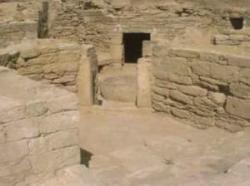 Kichik Dahna - The new settlement dated back to the Middle Bronze Age in the 3rd millennium BC has been found in Azerbaijan, Chief of Shaki-Gakh-Oghuz Archaeological Expedition of National Academy of Sciences of Azerbaijan (ANAS) Institute of Archaeology and Ethnography Nasib Mukhtarov told. He said there had been a continuous residence in the settlement found in Aghgabirli territory of Kichik Dahna village of Shaki region about 2000 years, from the end of the 3rd millennium BC until the beginning of the 1st millennium BC: “Archeological materials show that sedentary husbandry and cattle-breeding had been developed at that time. The settlement consists of two cultural layers. It shows that the site had been flooded at least twice. However, the site had been relocated for a short period of time. Ceramics, pottery pots, human and animal bones, stone tools, various agricultural tools made from limestone, different types of stone graters and mortars were found during the excavations. Metal has not been found yet.” Mukhtarov said that necropolis and burial mounds have also been recorded near Aghgabirli settlement. These burial mounds are located near Aghdara necropolis that include up to 120 burial mounds with collapsed surface as a result of tractors plowing.
Kichik Dahna - The new settlement dated back to the Middle Bronze Age in the 3rd millennium BC has been found in Azerbaijan, Chief of Shaki-Gakh-Oghuz Archaeological Expedition of National Academy of Sciences of Azerbaijan (ANAS) Institute of Archaeology and Ethnography Nasib Mukhtarov told. He said there had been a continuous residence in the settlement found in Aghgabirli territory of Kichik Dahna village of Shaki region about 2000 years, from the end of the 3rd millennium BC until the beginning of the 1st millennium BC: “Archeological materials show that sedentary husbandry and cattle-breeding had been developed at that time. The settlement consists of two cultural layers. It shows that the site had been flooded at least twice. However, the site had been relocated for a short period of time. Ceramics, pottery pots, human and animal bones, stone tools, various agricultural tools made from limestone, different types of stone graters and mortars were found during the excavations. Metal has not been found yet.” Mukhtarov said that necropolis and burial mounds have also been recorded near Aghgabirli settlement. These burial mounds are located near Aghdara necropolis that include up to 120 burial mounds with collapsed surface as a result of tractors plowing.
http://en.apa.az/news_ancient_settlement_discovered_in_azerbai_188982.html
GRECE – 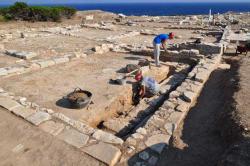 Despotikon - The important excavation, which is being conducted in the last few years, on the little island Despotikon and the islet Tsimindiri, near Antiparos, by the 21st Ephorate of Prehistoric and Classical Antiquities, and directed by archaeologist Giannos Kouragios, will continue.After receiving the approval of the Central Archaeological Council and obtaining grants from the Kanellopoulos and Latsis Foundations, the new five-year excavation program is expected to reveal parts of a significant Archaic sanctuary, dedicated to the cult of Apollo and Artemis. The inhabitants of Paros built this temple on Despotikon, as a sign of their predominance in the Aegean. During the excavations, the tower and the two rectangular buildings will also be investigated, which haven’t been excavated yet. In addition, the numerous rooms of the southern complex on Despotikon will be examined. The archaeological surveys will also include the five buildings revealed on Tsimindiri. Up to now, 12 buildings have been located on the uninhabited islet of Depotikon, and 5 on Tsimindiri, which in the past was connected by an isthmus to Despotikon. Among many finds, in the sanctuary archaeologists have found 20 marble bases of Archaic statues, 65 parts of Kouroi, the head of a Kore, and part of a marble Archaic life-sized Kouros, which was revealed this year on the island. Archaeologists also plan a small scale restoration of the sanctuary –namely the elevation of some columns, so that the third dimension of the temple can be recovered, which at some point in the past reached eight meters in height. Of course before doing that they would have to receive the “green light” from the Central Archaeological Council. As for the vision of archaeologists Giannos Kouragios, to create an archaeological park on Despotikon, for now it remains unfulfilled, due to the peculiar ownership situation of the islet.
Despotikon - The important excavation, which is being conducted in the last few years, on the little island Despotikon and the islet Tsimindiri, near Antiparos, by the 21st Ephorate of Prehistoric and Classical Antiquities, and directed by archaeologist Giannos Kouragios, will continue.After receiving the approval of the Central Archaeological Council and obtaining grants from the Kanellopoulos and Latsis Foundations, the new five-year excavation program is expected to reveal parts of a significant Archaic sanctuary, dedicated to the cult of Apollo and Artemis. The inhabitants of Paros built this temple on Despotikon, as a sign of their predominance in the Aegean. During the excavations, the tower and the two rectangular buildings will also be investigated, which haven’t been excavated yet. In addition, the numerous rooms of the southern complex on Despotikon will be examined. The archaeological surveys will also include the five buildings revealed on Tsimindiri. Up to now, 12 buildings have been located on the uninhabited islet of Depotikon, and 5 on Tsimindiri, which in the past was connected by an isthmus to Despotikon. Among many finds, in the sanctuary archaeologists have found 20 marble bases of Archaic statues, 65 parts of Kouroi, the head of a Kore, and part of a marble Archaic life-sized Kouros, which was revealed this year on the island. Archaeologists also plan a small scale restoration of the sanctuary –namely the elevation of some columns, so that the third dimension of the temple can be recovered, which at some point in the past reached eight meters in height. Of course before doing that they would have to receive the “green light” from the Central Archaeological Council. As for the vision of archaeologists Giannos Kouragios, to create an archaeological park on Despotikon, for now it remains unfulfilled, due to the peculiar ownership situation of the islet.
http://www.archaiologia.gr/en/blog/2013/03/08/new-archaeological-excavations-on-the-island-despotikon/
ROYAUME UNI – 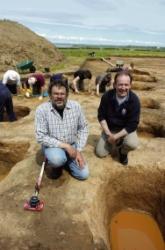 Maryport A tiny scrap of wool found during an archaeological dig in Maryport has unlocked a piece of history. Archaeologists revealed this week that the dig at Camp Farm last summer has unearthed what appears to be a Christian church, dating back to the 5th or 6th century. Experts believe the possible church, built in an east-west direction, was positioned so it could be seen at Whithorn, the cradle of Christianity in Scotland, on the other side of the Solway Firth. Tony Wilmott, site director, said that volunteers on the dig had discovered what appeared to be Christian long cist graves. In one they found fragments of bone and a tooth. Forensic work has since discovered that the remains may be of an individual, possibly a girl, aged about 14 but was unable to carbon date the remains. He added: “However, one of the graduate students, Lauren Proctor, discovered a small fragment of textile while processing soil samples from one of the graves. “It was a tiny piece of wool no bigger than my fingernail. The remarkable thing was that it has survived all these centuries.” Radiocarbon dating indicated that the fleece was probably sheared between AD 240 and AD 340, placing it in a late Roman context. Dig director Professor Ian Haynes, of Newcastle University, said: “This is big news. Maryport was already an important site. “The discovery of pits containing altars in 1870 led to a belief that these stones were ritually buried by the Roman army. This is something that became accepted. “What we discovered was that the altars were actually buried as ballast to support the large posts used for the church buildings.” He added that activity at the church site may well have begun before 410 AD and that a Latin-using Christian community occupied the hill top for some decades afterwards. Mr Wilmott said: “In the end, the least unlikely explanation is that the structures include a Christian church.”
Maryport A tiny scrap of wool found during an archaeological dig in Maryport has unlocked a piece of history. Archaeologists revealed this week that the dig at Camp Farm last summer has unearthed what appears to be a Christian church, dating back to the 5th or 6th century. Experts believe the possible church, built in an east-west direction, was positioned so it could be seen at Whithorn, the cradle of Christianity in Scotland, on the other side of the Solway Firth. Tony Wilmott, site director, said that volunteers on the dig had discovered what appeared to be Christian long cist graves. In one they found fragments of bone and a tooth. Forensic work has since discovered that the remains may be of an individual, possibly a girl, aged about 14 but was unable to carbon date the remains. He added: “However, one of the graduate students, Lauren Proctor, discovered a small fragment of textile while processing soil samples from one of the graves. “It was a tiny piece of wool no bigger than my fingernail. The remarkable thing was that it has survived all these centuries.” Radiocarbon dating indicated that the fleece was probably sheared between AD 240 and AD 340, placing it in a late Roman context. Dig director Professor Ian Haynes, of Newcastle University, said: “This is big news. Maryport was already an important site. “The discovery of pits containing altars in 1870 led to a belief that these stones were ritually buried by the Roman army. This is something that became accepted. “What we discovered was that the altars were actually buried as ballast to support the large posts used for the church buildings.” He added that activity at the church site may well have begun before 410 AD and that a Latin-using Christian community occupied the hill top for some decades afterwards. Mr Wilmott said: “In the end, the least unlikely explanation is that the structures include a Christian church.”
http://www.timesandstar.co.uk/news/other/scrap-of-wool-unravels-christian-church-find-1.1040877?referrerPath=/t_s_news_feed_1_17079
ROYAUME UNI – 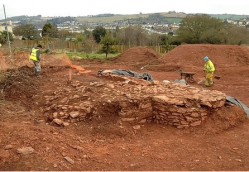 Kingskerswell - Fresh finds at a buried medieval settlement has prompted a wider search at the site of a long-awaited link road. Archaeologists uncovered 2,000-year-old Roman remains on land earmarked for the South Devon Link Road. They came across a large rectangular enclosure in December alongside an 800-year-old medieval building near Kingswerswell. Now another medieval building has been found at Edginswell Lane, with pottery dating back to the 13th century. More than 50kg of pottery has so far been dug up, originating from as far away as southern France and Spain. The 5.5km dual carriageway, which will provide the long awaited bypass for Kingskerswell, was given full approval by the government in May. Work began in October and is due to be completed by December 2015. Further assessment will now take place along the rest of the planned route to "establish archaeological potential". It is hoped that more detail will emerge around the medieval building as well as around the Roman settlement site at Aller Cross.
Kingskerswell - Fresh finds at a buried medieval settlement has prompted a wider search at the site of a long-awaited link road. Archaeologists uncovered 2,000-year-old Roman remains on land earmarked for the South Devon Link Road. They came across a large rectangular enclosure in December alongside an 800-year-old medieval building near Kingswerswell. Now another medieval building has been found at Edginswell Lane, with pottery dating back to the 13th century. More than 50kg of pottery has so far been dug up, originating from as far away as southern France and Spain. The 5.5km dual carriageway, which will provide the long awaited bypass for Kingskerswell, was given full approval by the government in May. Work began in October and is due to be completed by December 2015. Further assessment will now take place along the rest of the planned route to "establish archaeological potential". It is hoped that more detail will emerge around the medieval building as well as around the Roman settlement site at Aller Cross.
http://www.thisissouthdevon.co.uk/Medieval-building-route-new-Kingskerswell-link/story-18353781-detail/story.html#axzz2Mz30ts4f
USA – 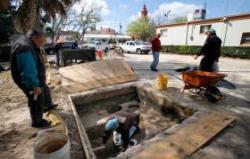 St Augustine - A half-dozen test pits pockmark what was the east parking lot of Flagler College’s Communications Building at the corner of Cordova and Cuna streets. In this case the digging is uncovering pieces of the Minorcan culture in an area once known as Little San Felipe. The area the structures will go into is part of what was the colonial walled city of the First Spanish Period (1565 to 1763). The property was first owned by a Diego Hernandez and later by an individual named Sanchez. But what Halbirt and his crew are finding the most of rare items related to the Minorcans. “It’s only 150 feet by 150 feet, but when you look at the amount of history potentially in this area you need to take the time to investigate,” Halbirt said. At some point the building now there will be torn down and further exploration will commence. The dig is expected to continue to late May or early June and the next area coming under their trowels will be the west parking lot of the site. That area is closer to the Rosario Line, an earthen wall that was part of the city’s defenses and built during the First Spanish Period. More Spanish items may turn up then. For now the focus is Minorcan. The Minorcans arrived in St. Augustine in 1777 after a grim time as laborers in a colony run by Dr. Andrew Turnbull at New Smyrna. St. Augustine was a British colony, and Gov. Patrick Tonyn allowed the 600 Minorcans still alive to come to the city. That was about half the number who had arrived in the New World in 1768.
St Augustine - A half-dozen test pits pockmark what was the east parking lot of Flagler College’s Communications Building at the corner of Cordova and Cuna streets. In this case the digging is uncovering pieces of the Minorcan culture in an area once known as Little San Felipe. The area the structures will go into is part of what was the colonial walled city of the First Spanish Period (1565 to 1763). The property was first owned by a Diego Hernandez and later by an individual named Sanchez. But what Halbirt and his crew are finding the most of rare items related to the Minorcans. “It’s only 150 feet by 150 feet, but when you look at the amount of history potentially in this area you need to take the time to investigate,” Halbirt said. At some point the building now there will be torn down and further exploration will commence. The dig is expected to continue to late May or early June and the next area coming under their trowels will be the west parking lot of the site. That area is closer to the Rosario Line, an earthen wall that was part of the city’s defenses and built during the First Spanish Period. More Spanish items may turn up then. For now the focus is Minorcan. The Minorcans arrived in St. Augustine in 1777 after a grim time as laborers in a colony run by Dr. Andrew Turnbull at New Smyrna. St. Augustine was a British colony, and Gov. Patrick Tonyn allowed the 600 Minorcans still alive to come to the city. That was about half the number who had arrived in the New World in 1768.
http://staugustine.com/news/local-news/2013-03-07/dig-reveals-minorcan-items#.UTpQ4Rw03mA